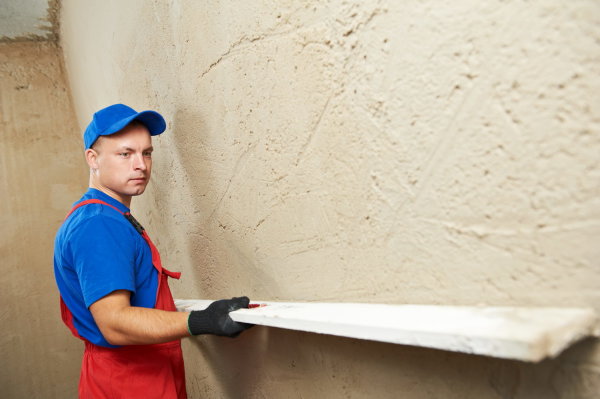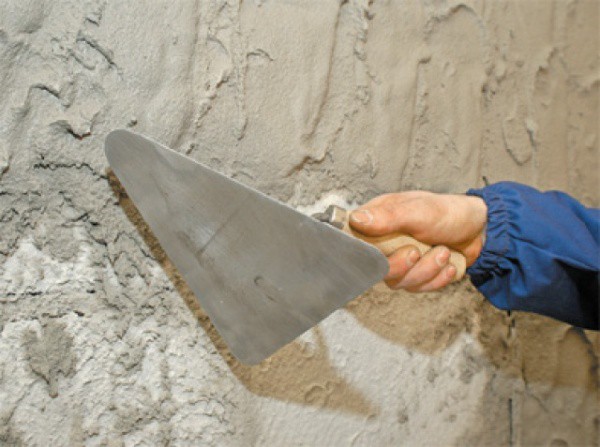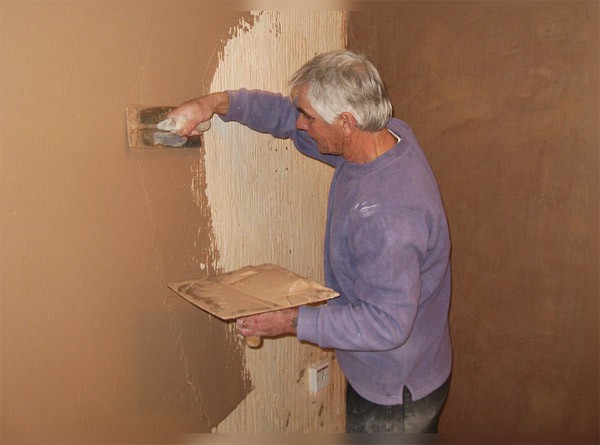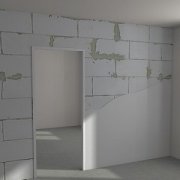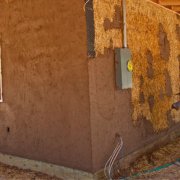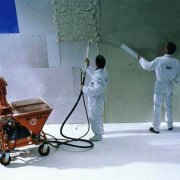Applying Stucco to a Wall: Video Lesson
How to properly apply plaster on the walls, we will consider today in detail. There are some features and details that you need to know. Also in the video in this article and photo you can see the individual moments of the work and do it yourself.
The content of the article
Different types of solutions
Currently, as a rule, it is customary to use solutions for applying to the plane of the wall bought in construction stores.
Among all solutions, mixtures of the following components are most often used:
| Cement - lime mortar | They are used for walls, the construction of which used brick, aerated concrete, concrete, as well as walls with an external ceramic surface. Normal humidity is required. Such solutions basically consist of the following components: sand, cement and lime, as well as a small amount of chemical additives that can improve the physical properties of this solution (increased temperature range for use); |
| Cement - sand mortars | Absolutely unpretentious type of solution, which is suitable for any working conditions. Perfect for outdoor decoration. He is not afraid of temperature extremes and high humidity. |
| Gypsum mortar | Suitable for finishing or finishing. Do not use in rooms where high humidity prevails or a combination with cement is possible. |
| Decorative plaster | It is also necessary to consider the existence of decorative textured plaster, which is used for the final lining of the treated surface. Basically, she does the modeling and decoration of decorative structures. For example, it could be a fireplace. |
How to apply the solution to the wall surface
There are several methods for applying the finished mixture to the wall surface, in addition, the use of various construction tools is permissible:
- A simple method. It is usually applied in several layers, it is used in non-residential premises (basements, cellars, garages).
- Improved method. It is applied in premises, and also rooms of public use. It is applied in three or more layers with a final fine finish.
- High quality method. Finishing is carried out in accordance with all the rules for applying plaster (using beacons) and using expensive materials and properly selected tools.
What is the price of the question
There can be no definite and concrete answer to such a question.
Price boundaries are blurred by the choice of materials and tools, as well as other factors that determine the final price:
- Contractor of work. If the work will be done on its own, then you will not have to spend money on renting workers. Moreover, renting a highly skilled plasterer is not cheap.
- The base of the surface is also taken into account when performing work. The cost of applying the finished solutions to different types of bases will vary.
- The shape of the wall plane. Work performed on ideal wall planes without niches, doorways and other obstructions is rated much lower than planes that have an intricate shape.
- The thickness of the solution used.In this case, the price will consist of the amount of solution on the surface to be treated, the use of retaining nets and the additional time that the worker will spend on the work.
- The material used for plastering the surface. The most budgetary option is the use of cement - sand mortars (see. Let's consider how to plaster cement-sand mortar).
Difficulties and defects that arise during work
Flaws in the plastering of the surface may be due to improper choice of mortar, violation of the technology of applying layers on the wall or insufficient drying of the material used.
The most commonplace ones:
- Shrinkage cracks. They arise due to excessively fast drying of the plastered surface, due to too high temperature or the presence of drafts in the room. In addition, their appearance is possible due to the application of a new layer of plaster on the dry previous layer.
- Lumps. The occurrence of these defects is due to poor-quality preparation of the solution or outstanding lime.
- Peeling. They appear due to the application of the solution on an unprepared or uncleaned surface. In addition, such a defect manifests itself due to the use of a combination of incompatible solutions (for example, gypsum and lime: lime mixtures dry, gypsum expand).
- Swelling. It occurs due to the premature performance of work on insufficiently dried surfaces, as well as when using a combination of gypsum mortar and cement wall.
- Roughness. It manifests itself with poorly sifted sand and insufficient grouting of the plastered surface.
Basic principles observed during the work
Strictly following the rules recommended by professionals, you can perform the required work on surface treatment as quickly and efficiently as possible:
- Humidity of the room where it is planned to carry out work should not exceed 60%. The temperature range should be between 5 and 30 degrees Celsius. Such conditions are recommended to be maintained for 72 hours after completion of work.
- Follow the manufacturer's recommendations, the recommendations of which are indicated on the back of the packaging during the production of the solution.
- Observe the hygiene of the workplace. All tools must be clean before starting a new type of work. It’s easier to clean a fresh solution than to leave the tool in water.
- Before applying the next coat, be sure to check the previous coat for drying. This is done by visual inspection, as well as by feeling the surface (it should not have dents or areas that crumble).
- Start work must be done from the ceiling, only then transferred to the walls.
Preparatory work
An important point: remember that before priming, the surface to be treated should be thoroughly cleaned - otherwise the level of penetration into the walls will not be so deep and there will be low adhesion of surfaces.
- After cleaning the plane, we need to see which layer of plaster to apply. To do this, the line is pulled along the diagonals and everything is immediately visible.
- If the wall is made of bricks, then it will not be superfluous to deepen the seams. Then the coating will hold on better.
- Now you need to choose the right soil. For various wall materials different types of primer: for concrete walls - mineral, for brick - acrylic, etc.
- Before starting work on plastering the walls, it is necessary to treat the surface with a primer. This will protect the treated surfaces from mold or fungus, as well as apply a pre-prepared solution with a more even layer.
Varieties of primers:
| Acrylic primer | The polymer and most versatile mixture that is used on most surfaces, excluding metal ones.It also has a fairly quick drying time - up to 5 hours and does not have an unpleasant odor. |
| Alkyd primer | This solution is usually used for wooden wall surfaces and particleboard. Drying time is up to 15 hours. |
| Phenolic primer | A solution containing anti-corrosion substances, a solvent and a mixture of varnish. It is used for initial work on metal and wooden substrates. |
| Vinyl chloride primer | Toxic type of primer materials, which is used only in non-residential premises for metal or wooden substrates. |
Depending on the internal defects of the wall, the primers are applied in one or several layers using a roller or a wide paint brush.
- On loose surfaces that abundantly absorb moisture - several layers of primer are also applied (foam concrete).
- On surfaces with abundant surface drops, a mounting grid is attached.
Attention: Failure to comply with the recommendations for the application of primers threatens the appearance of mechanical damage or the formation of fungi in the future.
How to apply the mortar on the wall surface
Only after completion of preparatory work for cleaning and priming surfaces is it allowed to proceed directly to applying the finished mixture to the wall plane. Cement mortar for plaster is applied according to the classical scenario and includes 3 stages.
Consider these stages in more detail:
- Spray: a base layer of plaster, which should be less than 1 centimeter when using the mounting grid, for more durable wall surfaces - not more than 5 millimeters. The mixture is a doughy substance. Apply the solution until all the irregularities on the surface completely disappear. The thickness of the mixture used should also not exceed more than 1 centimeter. The final layer of the stucco mixture is a coating. The maximum thickness of the mixture has a maximum permissible value of 5 millimeters. Has a creamy substance.
- The base layer is applied by spraying the mixture onto the machined plane, using the extreme part of the trowel. This process is not difficult even for beginner plasterers. The mixture after application to the plane of the wall is not leveled. As a rule, they also throw it with the help of such auxiliary tools as a half-trick or a falcon (see Wall plastering tool: what you need to work) The mixture when moving the falcon is smeared on the wall.
- The use of a grater involves moving the tool with the solution from top to bottom. In order to apply the required amount of the mixture to the tool, the width of the canvas should exceed 20 centimeters. The number of layers applied directly depends on the desired thickness of the applied solution.
- The final layer is aligned using the rule, and the movements should be oblique and sharp. The rule processing step is performed until a smooth surface is obtained. The final layer is smeared with the help of a half-trick or rule auxiliary tool. Movements are made from the bottom up, smoothly moving the rule.
- When processing walls, follow the recommendations of professionals in the manufacture of mixtures of the necessary consistency, auxiliary tools used, as well as methods for applying solutions to the exterior of the wall. The end result is a somewhat roughened wall suitable for post-processing.
Now you know how to apply plaster on a wall, and how to apply plaster on a wall the video will show the sequence of work. If you do everything yourself, then the price will not be significant and the instruction will help you avoid mistakes.
